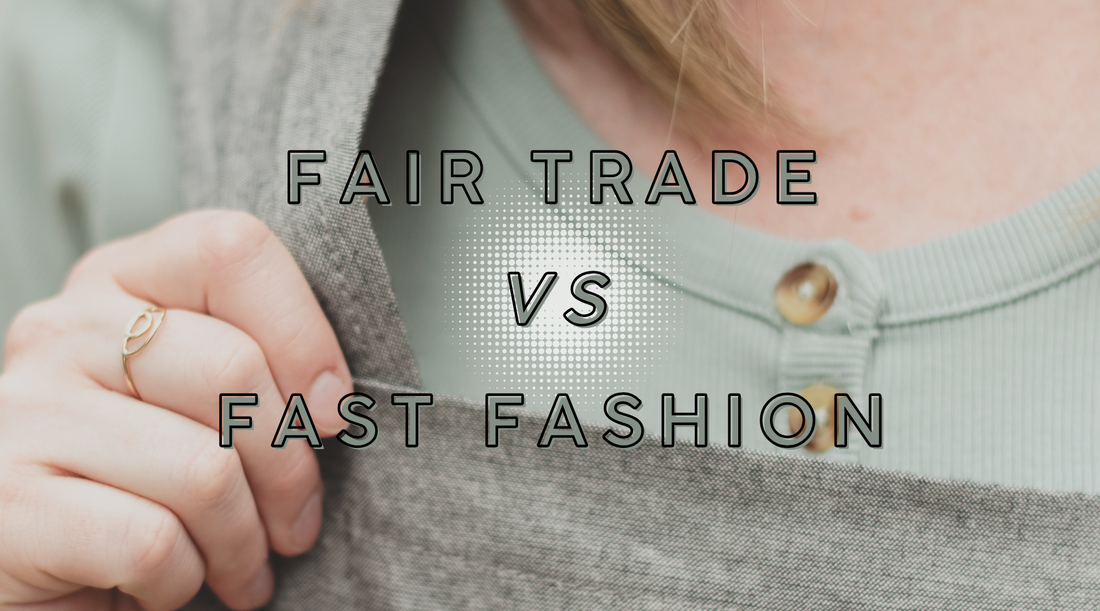
Fair Trade VS Fast Fashion
The internet is swimming with talk about the harms of fast fashion, but what is it, why does it matter, and how is fair trade any different? Let’s talk about it.

The Facts of Fast Fashion
The term ‘fast fashion’ references the “rapid production of inexpensive, low-quality clothing”. Some commonly known brands include SHEIN or H&M.
They are known for their low prices and quick turnover of styles, attempting to keep up with trends that rotate just as quickly. Besides the issues of low quality and false advertising, fast fashion seems to have become a fast detriment to the environment and the people making the clothes.
Climate & Labor Laws
When it comes to the environment, high textile waste, water usage, and CO2 emissions are just a few of the concerns that come along with producing thousands of clothing items a day.
In addition to the environmental toll, brands like Shein have faced reports of child labor, overtime violations, and extremely low wages, despite claims they are working to improve.
Both people and the planet are facing the repercussions for the actions of many clothing conglomerates. It can be overwhelming, but there’s good news: we can make a difference.
How Is Fair Trade Different?
A couple options include shopping second hand and embracing slow fashion which encourages repairing items until beyond repair and buying higher quality made to last. When shopping new or venturing into slow fashion, try fair trade.
Certified fair trade means brands are dedicated to supporting people and the planet. Artisan working conditions are vetted for cleanliness and safety and there is a no-tolerance policy for child and slave labor.
Many fair trade clothing options are made using recycled fabrics or scraps produced from other products or larger factories. What would otherwise be sent to landfill is now turned into high-quality garments made to last. One example is Latitudes’ Staunton Tee shirts made in Haiti using recycled water bottles, turning waste into super soft shirts.
Aside from recycled materials, a majority of fair trade clothing is known for high quality, natural, and organic materials. Fair trade also embraces ethical practices and quality, something that can be at odds with fast fashion’s low price points. Let’s talk about the costs and why fair trade prices are worth it.

Affordability of Fashion
Many people shopping fast fashion are there because of the cost. Compared to fast fashion, one concern is the sticker shock that can come with fair trade, sustainable, and slow fashion brands.
If you can’t spend more but don’t want to vote for wasteful and hurtful practices, many ethical brands have regular sales, offer discounts for new customers, or have a program where you can purchase lightly worn items for less. Secondhand is often even less than the price of fast fashion and popular styles are regularly donated. These are not the only options, but a couple examples.
It can be frustrating when a higher price tag doesn’t always mean higher quality, but with fair trade those worries are gone. Support the people making your clothes, safe working environments, and the use of recycled and natural materials with fair trade. Ultimately, it’s not just about price, it’s about what you’re voting for with your money.
It’s More Than Just Shopping
How you spend your money is a vote for that way of living, you are telling that brand, hey, I support this and want more of it. You also show competing brands what matters to you.
A capsule wardrobe, a collection of essential pieces that can be mixed and matched, is a great example that all you really need are the basics. The rest is up to your styling and unique items that have meaning to you.
When you aren’t spending money constantly on cheap clothes that fall apart quickly, you might find room in the budget for higher quality items that last. It’s like a mini-investment in yourself, people, and the planet. So in practice, what does this all mean?

The Round Up
Fast fashion is filling landfills, treating people poorly, and costing us all more in the long run. Second-hand and mending are always options. Fair Trade is actively making a difference in the clothing world, finding ways to repurpose and recycle, treating people and the planet fairly, and creating timeless pieces made to last.
While it can be enticing to follow trends and fall for the deal of a $5 shirt, remember that people make your clothes. The labor, materials, and time are often far beyond the asking price. The toll fast fashion items cost us after just a couple wears stays with us all for years to come.
Repair, repurpose, or donate clothing before heading straight to the trash bin. If you want to support ethical practices and vote for a better future for fashion, check out fair trade options like Latitudes Fair Trade Store.
